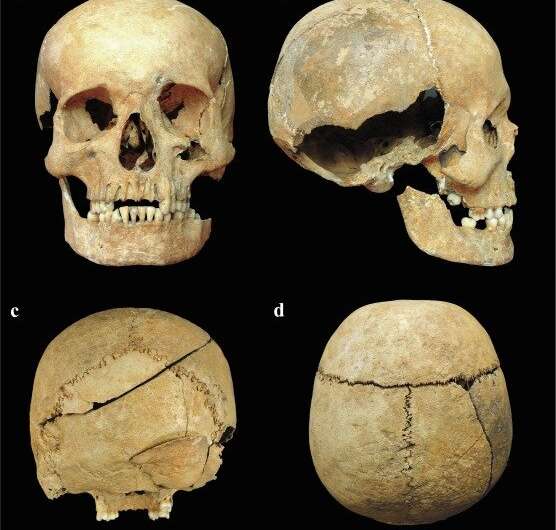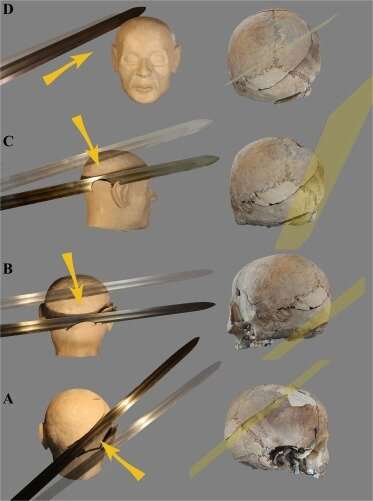Credit: Chiara Tesi et al, Wounded to death. Holistic, multimodal reconstruction of the dynamics in a case of multiple perimortem cranial injuries from a medieval site in northern Italy, Journal of Archaeological Science: Reports (2022). DOI: 10.1016/j.jasrep.2022.103643
A team of researchers from the University of Insubria and the University of Siena, both in Italy, has used modern tools to reconstruct the events that led to the death of a young man approximately 700 hundred years ago, in what is now Italy. In their paper published in Journal of Archaeological Science: Reports, the group describes how they used three-dimensional X-ray scans, computed tomography and precision digital microscopy to better understand the events that led to the death of a young Medieval man.
In 2006, the skeleton of a decapitated man was found near the entrance to a Medieval tomb that had been built in the 11th century. At the time, researchers suggested the location of the tomb indicated that the skeleton had likely once belonged to a member of the De Citillio family, who had built the church.
Initial study of the skeleton of the young man showed that he was approximately 19 to 24 years old when he died. He had the musculature of an archer and a healed wound on his forehead suggesting he had prior experience in warfare. Closer examination using X-ray technology, tomography and digital microscopy, allowed the researchers to create a virtual skull, which in turn helped to reveal the likely timeline of his death.
Credit: Chiara Tesi et al, Wounded to death. Holistic, multimodal reconstruction of the dynamics in a case of multiple perimortem cranial injuries from a medieval site in northern Italy, Journal of Archaeological Science: Reports (2022). DOI: 10.1016/j.jasrep.2022.103643
Examining the placement and angle of the wounds to the skull, the researchers found evidence that suggested the young man had been struck first on the front, top part of his head by a weapon, likely a sword as he faced his attacker. The wound was not deep, suggesting the victim had used a shield to deflect the blow. Then it appears he turned and began to run away.
But he was not able to escape and was hit on the head again, this time from behind, near his ear and then again on the back of the neck. Such blows appeared to have had enough force to knock the young man to the ground, perhaps making him unconscious. One more blow came, this one to the top, back part of the head. Its depth suggested that the young man was no longer attempting to ward off his attacker and that the attacker was intent on killing his victim. The last blow would also have meant nearly instant death.
More information: Chiara Tesi et al, Wounded to death. Holistic, multimodal reconstruction of the dynamics in a case of multiple perimortem cranial injuries from a medieval site in northern Italy, Journal of Archaeological Science: Reports (2022). DOI: 10.1016/j.jasrep.2022.103643
© 2023 Science X Network

























